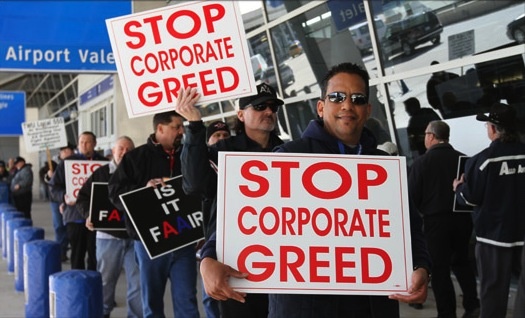Pension busting at American Airlines

By Phil Mattera, Dirt Diggers Digest
There was once a time when a bankruptcy filing by a company was a mark of shame. That stigma has fallen by the wayside, and firms now employ Chapter 11 not to protect themselves against creditors but for strategic purposes.
One of the most popular ploys is to use the bankruptcy court to undermine the bargaining position of labor unions. The latest firm to do so is American Airlines, which said it took the step to "achieve industry competitiveness." This is corporate-speak for "we're going to milk our employees dry."
Such union-busting bankruptcies are far from new. They were pioneered three decades ago by the likes of ruthless airline executive Frank Lorenzo, who used Chapter 11 to abrogate union contracts after taking over Continental Airlines in 1983. Six years later he tried something similar at Eastern Airlines, but changes in the law forced him to settle for weakening the unions rather than eliminating them altogether. Subsequently, most of the other major carriers (and various smaller ones) also went through the bankruptcy process.
Airline management has made the most of the system. In 2006 a federal bankruptcy court barred unions at regional carrier Mesaba Airlines from engaging in strikes or other job actions, prompting the company's unions to agree to management's wage-cutting demands. In 2008 a bankruptcy judge gave Frontier Airlines permission to cancel its collective bargaining agreement with the Teamsters, but that decision was later overruled in federal district court. The union, nonetheless, had to make contract concessions, as have workers at other carriers and in other industries.
It remains to be seen how far AMR will go in using the bankruptcy process against its unions. Yet there is little doubt that it will seek to slash labor costs, especially those relating to pensions. The head of the federal Pension Benefit Guaranty Corporation has already expressed concern that AMR might terminate its plans -- the way United Air Lines did during its stint in Chapter 11.
This would put an enormous strain on the PBGC, which has already amassed a deficit of $26 billion and would have difficulty providing significant payments to the tens of thousands of people covered by AMR's pension plans.
There is good reason for AMR's unions to be concerned about management's intentions. AMR's crusade against labor began three decades ago, when Robert Crandall took control of the company in the early days of airline industry deregulation. Apparently inspired by Reagan's crushing of the air controllers strike, he was determined to get workers to bear the financial consequences of increased competition.
In the early 1980s AMR was one of the country's first major employers to adopt the pernicious practice of two-tier wages. Crandall pressured unionized pilots to accept a contract that cut the pay of new hires by a whopping 50 percent; for flight attendants the reduction was more than 30 percent, making many of them eligible for food stamps. The moves transferred $100 million a year from paychecks to company coffers.
AMR also pioneered the practice of high-tech offshore outsourcing in 1983 when it set up a subsidiary in Barbados called Caribbean Data Services. The company began air-shipping tons of used ticket coupons to the facility, where operators (mostly women) paid $1.75 to $3 an hour entered the information on computer terminals and then transmitted it via satellite to the airline’s accounting center in Tulsa, Oklahoma. By 1985 the operation was successful enough in cutting costs that American shut down its data-entry operation in Tulsa.
When unions began to challenge the two-tier system in the late 1980s, AMR sued them for supposed violations of federal labor law, fired activists and threatened to shut down the airline. Eventually, Crandall had to accept a softening of the two-tier arrangement, but he pursued a relentless campaign against labor costs which prompted a 1993 strike by flight attendants that ended only when President Clinton personally intervened. Four years later, Clinton intervened again when American's pilots walked out to protest the company's rigid bargaining position.
Crandall's successor, Donald Carty, continued the company's confrontational labor relations posture. In 2003 he used the threat of bankruptcy to wring $1.8 billion in annual concessions from AMR's unions. While those negotiations were taking place, AMR management failed to mention that it was simultaneously offering lucrative retention bonuses and special pension protections to top executives at the company. When the plan came to light, the uproar was so intense that AMR's board ousted Carty and -- for a while -- adopted a less aggressive posture toward the unions. With the bankruptcy filing, the company appears to be returning to its savage ways.
When Occupy protesters or others talk about income inequality, conservatives complain that this is class warfare. The real class war is that being waged by corporations against decent wages and benefits, using the bankruptcy courts as one of their most effective weapons.
What makes this all the more galling is that severe restrictions have been placed on the ability of struggling individuals -- including young people overwhelmed by student loan debt -- to use the bankruptcy system to gain relief. Here, as in so many other areas, corporate "persons" have been given the upper hand over real people.
(Photo of American Airlines protests via Transport Workers Union website.)
